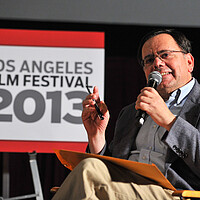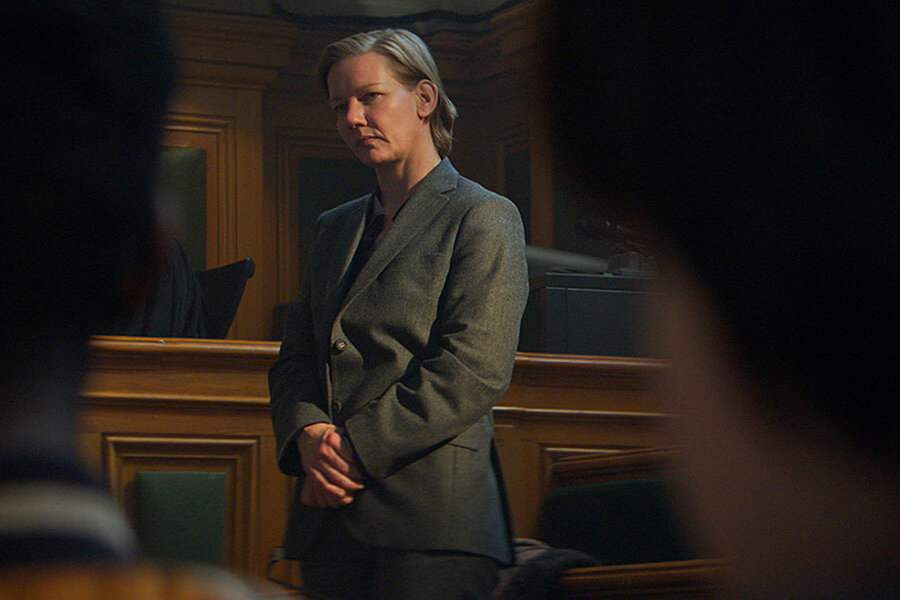Toronto film fest: Big-screen gems, absent movie stars
Loading...
| Toronto
With a film festival as huge as the one held in Toronto this month, it’s folly to attempt to connect the dots and discern global cinematic trends. But several films about the Holocaust loomed large, centering primarily on stories about rescue missions, and there was at least one first-rate documentary on Ukraine.
I had not attended the Toronto International Film Festival in four years, during which time the pandemic, until last year, had rendered it mostly virtual. The reunion was gratifying, and also somewhat disorienting. The event, after all, was taking place in the midst of a major Hollywood labor union strike.
Why We Wrote This
When a critic returns to a major film festival after a pandemic break, what will he find? Peter Rainer navigates Toronto – and an industry still dealing with dual strikes – and is rewarded with a top-notch cinematic passport.
As a film critic, I don’t regret the lack of glitz and glamour because writers and actors weren’t able to promote their projects. It made it much easier to focus on what I was in Toronto for in the first place: the movies.
One standout was “The Pigeon Tunnel,” a documentary about the late David Cornwell, aka author John le Carré. In it, Mr. Cornwell makes a comment that reflects how others in the work-halted film industry may be feeling, too: “Without the creative life,” he concludes, “I have very little identity.”
With a film festival as huge as the one held in Toronto this month, it’s folly to attempt to connect the dots and discern global cinematic trends. But several films about the Holocaust loomed large, centering primarily on stories about rescue missions, and there was at least one first-rate documentary on Ukraine.
I had not attended the Toronto International Film Festival (TIFF) in four years, during which time the pandemic, until last year, had rendered it mostly virtual.
The reunion was both gratifying – films were back on the big screen, with movie-mad audiences – and somewhat disorienting. The event, after all, was taking place amid two major Hollywood labor union strikes, as both the Writers Guild of America and the Screen Actors Guild-American Federation of Television and Radio Artists are embroiled in a monthslong faceoff with the Alliance of Motion Picture and Television Producers – with no end in sight.
Why We Wrote This
When a critic returns to a major film festival after a pandemic break, what will he find? Peter Rainer navigates Toronto – and an industry still dealing with dual strikes – and is rewarded with a top-notch cinematic passport.
What these strikes meant for the festival, which ends Sunday, was that unless a specific film obtained a waiver from the unions involved, no member actors or writers could appear at TIFF to promote their films. The red carpets were in no danger of being frayed.
As a film critic, I don’t regret the lack of glitz and glamour. It made it much easier to focus on what I was in Toronto for in the first place: the movies. I carved my way through more than 20 of them, out of several hundred representing 43 countries.
And there were some terrific offerings, along with the usual overhyped, underachieving entries. At the very least, seeing films from all over the world provided a kind of cinematic passport: If the international fare was not always excellent, the ethnography was.
Maciek Hamela’s “In the Rearview” brought the war in Ukraine to life with devastating immediacy. The Polish-born Hamela, making his debut feature, bought a van at the start of the war against Russia and began evacuating mostly women and children out of the war zone and into Poland. Most of the documentary is simply a rearview video recording of the van’s inhabitants as they crowd into the seats and, in many cases, pour out their hopes and woes. We see bombed-out houses along the road, and sometimes we hear rockets in the distance.
The movies about the Holocaust were made before the Ukraine conflict, but their depicted rescue efforts, as well as the experience of bearing witness to atrocity, nevertheless struck a contemporary chord.
“One Life” stars Anthony Hopkins as the real-life Nicholas Winton, a British stockbroker who in 1938 saved the lives of hundreds of Jewish children in Prague. The film moves between the 1930s sequences, conventionally shot, and the scenes with Hopkins as the self-effacing older Winton recalling those years. Hopkins’ scenes are by far the best. What a versatile actor he is. But there was a particularly poignant moment at the conclusion of the public screening of the film, when the festival moderator asked audience members who were the offspring of the saved children to stand up. I counted over a dozen people.
“Lee,” a directorial debut for Ellen Kuras and starring Kate Winslet as the American photojournalist Lee Miller, also features powerful Holocaust sequences. Except for Winslet’s ferocious performance, though, the movie overall disappoints. Miller was a former model who became a photographer for Vogue and shot the death camp photos that the American edition of the magazine ran during the war, among the first such photos to be published. It was Miller who talked her way into entering Hitler’s abandoned Berlin home and photographed herself bathing in the Führer’s tub, an iconic moment reproduced in the movie.
One Holocaust movie decidedly not in the savior mode is Jonathan Glazer’s “The Zone of Interest,” loosely drawn from Martin Amis’ 2014 novel. Set in the waning days of the war, it centers on the commandant of Auschwitz, played by Christian Friedel; his wife Hedwig, played by Sandra Hüller; and their children. They reside right across from the death camp, and their quotidian domestic goings-on are backdropped by the clangor of the camp and the smoke rising from the crematoria. Nothing of the prisoners is shown from inside Auschwitz. The winner of the Grand Prix at the Cannes Film Festival earlier this year, it was by far the most chilling movie I saw in Toronto and one of the very best. (Unrated, releases Dec. 8.)
Hüller is also the star of Justine Triet’s “Anatomy of a Fall,” which won the Palme d’Or at Cannes, that festival’s highest honor. The film garnered her major attention for her role as a German novelist accused of possibly murdering her husband. It’s always bracing to encounter an explosive international talent in multiple festival offerings, and Toronto is an ideal place for such finds. Seeing Hüller in such disparate roles is a reminder of how chameleonlike the art of acting is. (Rated R, releases Oct. 13.)
The art of acting was also on full display with director Anand Tucker’s “The Critic.” Ian McKellen plays a 1930s English drama critic who, faced with dismissal from his newspaper, engineers a dastardly plot to reclaim his job. It’s a deliciously vinegary performance, and I, for one, take no personal offense at the swipe at such an august profession.
I’ve saved some of the best for last: Documentaries are always standouts at TIFF.
“Silver Dollar Road,” directed by Raoul Peck (“I Am Not Your Negro”), is drawn from a 2019 reported piece by Lizzie Presser published by ProPublica and The New Yorker. It details how a North Carolina waterfront property owned for generations by an African American family, the Reels, was taken over by developers, who sought to drive them out – with two of the descendants choosing to go to jail rather than relinquish their homes. (Rated PG; released in select theaters Oct. 13, streaming on Amazon Prime Video Oct. 20.)
“In Restless Dreams,” Alex Gibney’s 3 1/2-hour documentary, is an in-depth portrait of Paul Simon, ranging from his high school days with Art Garfunkel to the production of his new album, “Seven Psalms.” Simon’s music is so expressive that it’s fascinating to note just how recessive a camera subject he is. He’s also, unsurprisingly, not a fan of celebrity. “Fame,” he says, “is a poison.”
Errol Morris’ “The Pigeon Tunnel” (rated PG-13, releases Oct. 20) reveals David Cornwell, aka author John le Carré, as an enigma as great as any single or double agent he ever penned. It was the last full interview Cornwell gave before his death in 2020, and he revels in tales of spies, his con man father, and how one can become addicted to betrayal.
His thoughts reflect what some in the work-halted film industry may be feeling as well: “Without the creative life,” he concludes, “I have very little identity.”
Peter Rainer is the Monitor’s film critic. Movies listed above without release dates are currently up for sale and are not yet rated.











